Article Review: Exploring International Tourism Research
VerifiedAdded on 2021/10/05
|8
|2257
|130
Report
AI Summary
This report is an article review that critically examines five articles related to international tourism. The review covers a range of topics, including the impact of festivals on visitor perceptions (Axelsen & Swan, 2010), the role of food festivals in attracting tourists (Chang & Yuan, 2011), the principles of ecotourism and its environmental effects (Buckley, 2009), the factors that contribute to memorable tourism experiences (Tung & Ritchie, 2011), and the application of zoning in managing tourism activities (Roman, Dearden & Rollands, 2007). The student analyzes each article, highlighting key findings, methodologies, and the importance of each study to the tourism sector. The review emphasizes the dynamic nature of tourism, the significance of understanding customer motivations, the importance of sustainability and environmental protection, and the value of creating memorable experiences to enhance customer satisfaction. The articles selected provide insights into the multifaceted aspects of tourism management, from event planning to environmental conservation, and the review offers a comprehensive overview of the current research and its implications for the industry.
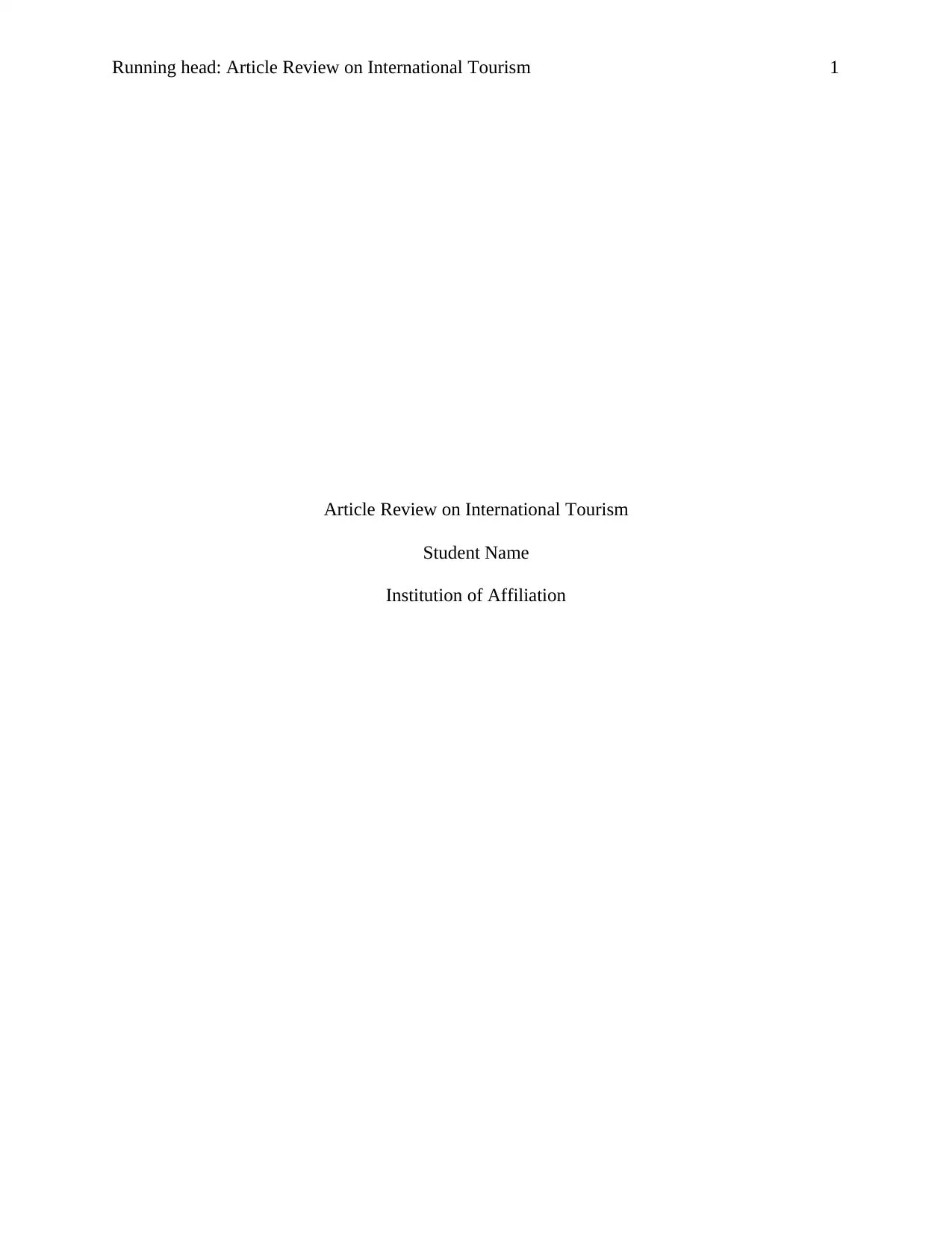
Running head: Article Review on International Tourism 1
Article Review on International Tourism
Student Name
Institution of Affiliation
Article Review on International Tourism
Student Name
Institution of Affiliation
Paraphrase This Document
Need a fresh take? Get an instant paraphrase of this document with our AI Paraphraser
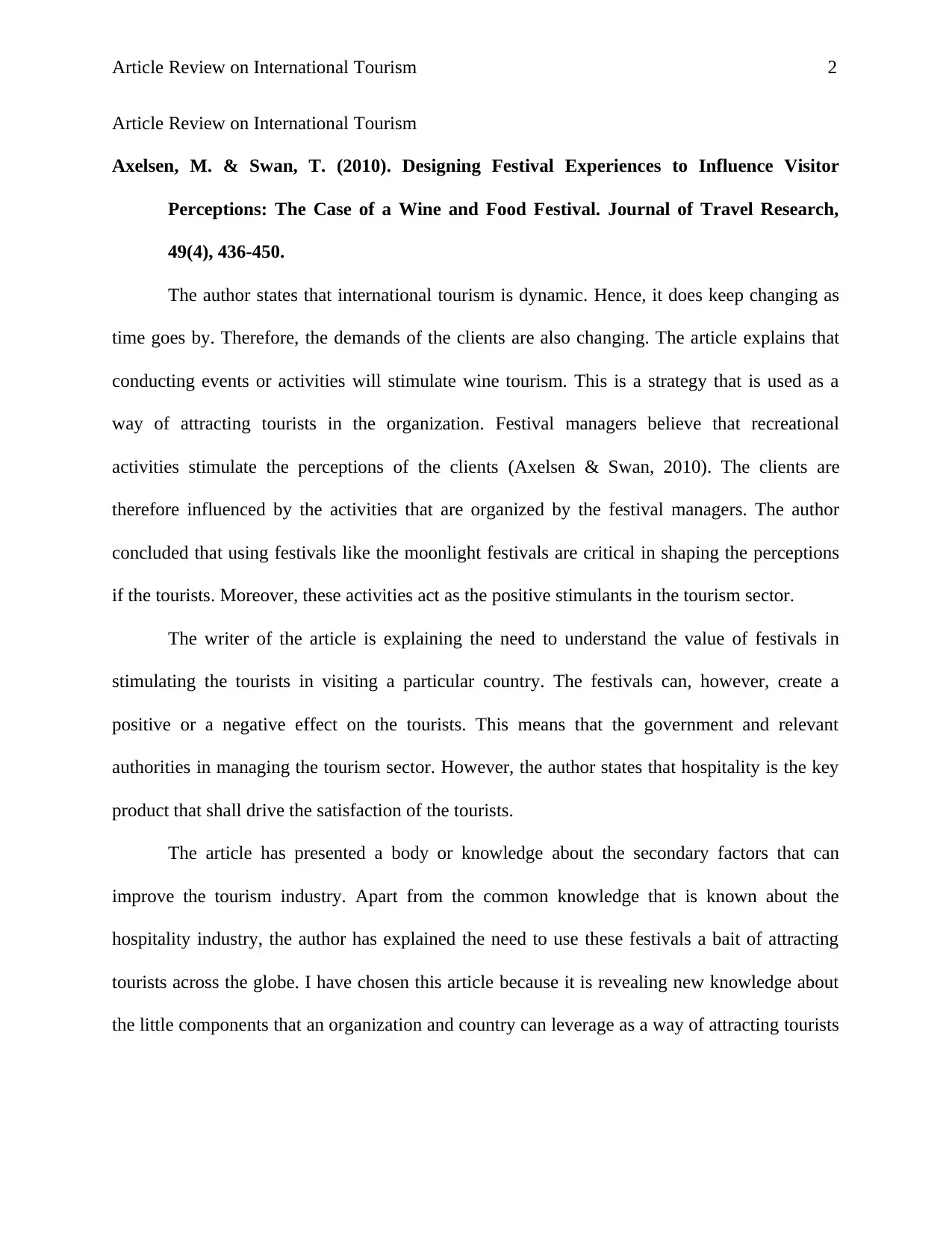
Article Review on International Tourism 2
Article Review on International Tourism
Axelsen, M. & Swan, T. (2010). Designing Festival Experiences to Influence Visitor
Perceptions: The Case of a Wine and Food Festival. Journal of Travel Research,
49(4), 436‐450.
The author states that international tourism is dynamic. Hence, it does keep changing as
time goes by. Therefore, the demands of the clients are also changing. The article explains that
conducting events or activities will stimulate wine tourism. This is a strategy that is used as a
way of attracting tourists in the organization. Festival managers believe that recreational
activities stimulate the perceptions of the clients (Axelsen & Swan, 2010). The clients are
therefore influenced by the activities that are organized by the festival managers. The author
concluded that using festivals like the moonlight festivals are critical in shaping the perceptions
if the tourists. Moreover, these activities act as the positive stimulants in the tourism sector.
The writer of the article is explaining the need to understand the value of festivals in
stimulating the tourists in visiting a particular country. The festivals can, however, create a
positive or a negative effect on the tourists. This means that the government and relevant
authorities in managing the tourism sector. However, the author states that hospitality is the key
product that shall drive the satisfaction of the tourists.
The article has presented a body or knowledge about the secondary factors that can
improve the tourism industry. Apart from the common knowledge that is known about the
hospitality industry, the author has explained the need to use these festivals a bait of attracting
tourists across the globe. I have chosen this article because it is revealing new knowledge about
the little components that an organization and country can leverage as a way of attracting tourists
Article Review on International Tourism
Axelsen, M. & Swan, T. (2010). Designing Festival Experiences to Influence Visitor
Perceptions: The Case of a Wine and Food Festival. Journal of Travel Research,
49(4), 436‐450.
The author states that international tourism is dynamic. Hence, it does keep changing as
time goes by. Therefore, the demands of the clients are also changing. The article explains that
conducting events or activities will stimulate wine tourism. This is a strategy that is used as a
way of attracting tourists in the organization. Festival managers believe that recreational
activities stimulate the perceptions of the clients (Axelsen & Swan, 2010). The clients are
therefore influenced by the activities that are organized by the festival managers. The author
concluded that using festivals like the moonlight festivals are critical in shaping the perceptions
if the tourists. Moreover, these activities act as the positive stimulants in the tourism sector.
The writer of the article is explaining the need to understand the value of festivals in
stimulating the tourists in visiting a particular country. The festivals can, however, create a
positive or a negative effect on the tourists. This means that the government and relevant
authorities in managing the tourism sector. However, the author states that hospitality is the key
product that shall drive the satisfaction of the tourists.
The article has presented a body or knowledge about the secondary factors that can
improve the tourism industry. Apart from the common knowledge that is known about the
hospitality industry, the author has explained the need to use these festivals a bait of attracting
tourists across the globe. I have chosen this article because it is revealing new knowledge about
the little components that an organization and country can leverage as a way of attracting tourists
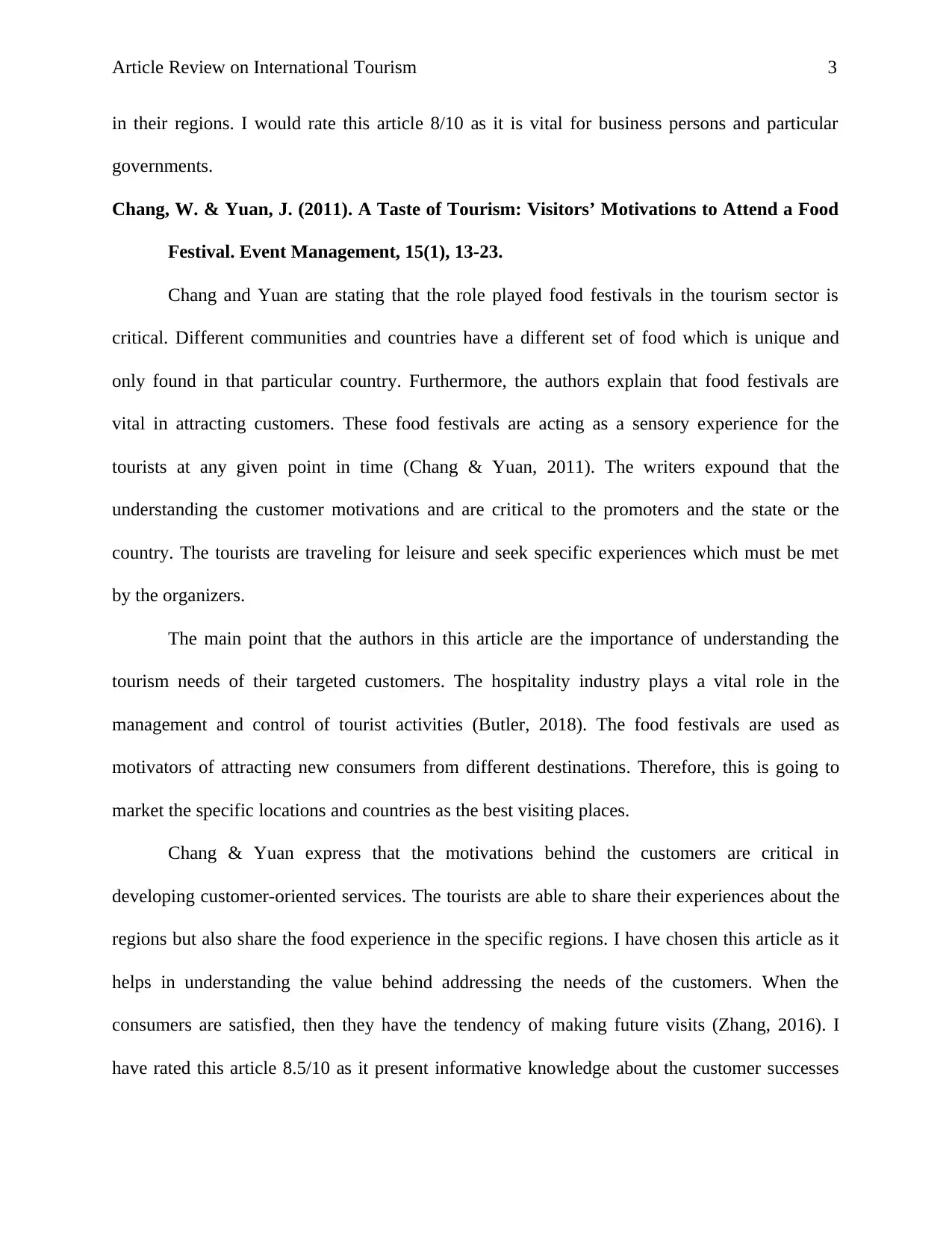
Article Review on International Tourism 3
in their regions. I would rate this article 8/10 as it is vital for business persons and particular
governments.
Chang, W. & Yuan, J. (2011). A Taste of Tourism: Visitors’ Motivations to Attend a Food
Festival. Event Management, 15(1), 13‐23.
Chang and Yuan are stating that the role played food festivals in the tourism sector is
critical. Different communities and countries have a different set of food which is unique and
only found in that particular country. Furthermore, the authors explain that food festivals are
vital in attracting customers. These food festivals are acting as a sensory experience for the
tourists at any given point in time (Chang & Yuan, 2011). The writers expound that the
understanding the customer motivations and are critical to the promoters and the state or the
country. The tourists are traveling for leisure and seek specific experiences which must be met
by the organizers.
The main point that the authors in this article are the importance of understanding the
tourism needs of their targeted customers. The hospitality industry plays a vital role in the
management and control of tourist activities (Butler, 2018). The food festivals are used as
motivators of attracting new consumers from different destinations. Therefore, this is going to
market the specific locations and countries as the best visiting places.
Chang & Yuan express that the motivations behind the customers are critical in
developing customer-oriented services. The tourists are able to share their experiences about the
regions but also share the food experience in the specific regions. I have chosen this article as it
helps in understanding the value behind addressing the needs of the customers. When the
consumers are satisfied, then they have the tendency of making future visits (Zhang, 2016). I
have rated this article 8.5/10 as it present informative knowledge about the customer successes
in their regions. I would rate this article 8/10 as it is vital for business persons and particular
governments.
Chang, W. & Yuan, J. (2011). A Taste of Tourism: Visitors’ Motivations to Attend a Food
Festival. Event Management, 15(1), 13‐23.
Chang and Yuan are stating that the role played food festivals in the tourism sector is
critical. Different communities and countries have a different set of food which is unique and
only found in that particular country. Furthermore, the authors explain that food festivals are
vital in attracting customers. These food festivals are acting as a sensory experience for the
tourists at any given point in time (Chang & Yuan, 2011). The writers expound that the
understanding the customer motivations and are critical to the promoters and the state or the
country. The tourists are traveling for leisure and seek specific experiences which must be met
by the organizers.
The main point that the authors in this article are the importance of understanding the
tourism needs of their targeted customers. The hospitality industry plays a vital role in the
management and control of tourist activities (Butler, 2018). The food festivals are used as
motivators of attracting new consumers from different destinations. Therefore, this is going to
market the specific locations and countries as the best visiting places.
Chang & Yuan express that the motivations behind the customers are critical in
developing customer-oriented services. The tourists are able to share their experiences about the
regions but also share the food experience in the specific regions. I have chosen this article as it
helps in understanding the value behind addressing the needs of the customers. When the
consumers are satisfied, then they have the tendency of making future visits (Zhang, 2016). I
have rated this article 8.5/10 as it present informative knowledge about the customer successes
⊘ This is a preview!⊘
Do you want full access?
Subscribe today to unlock all pages.

Trusted by 1+ million students worldwide
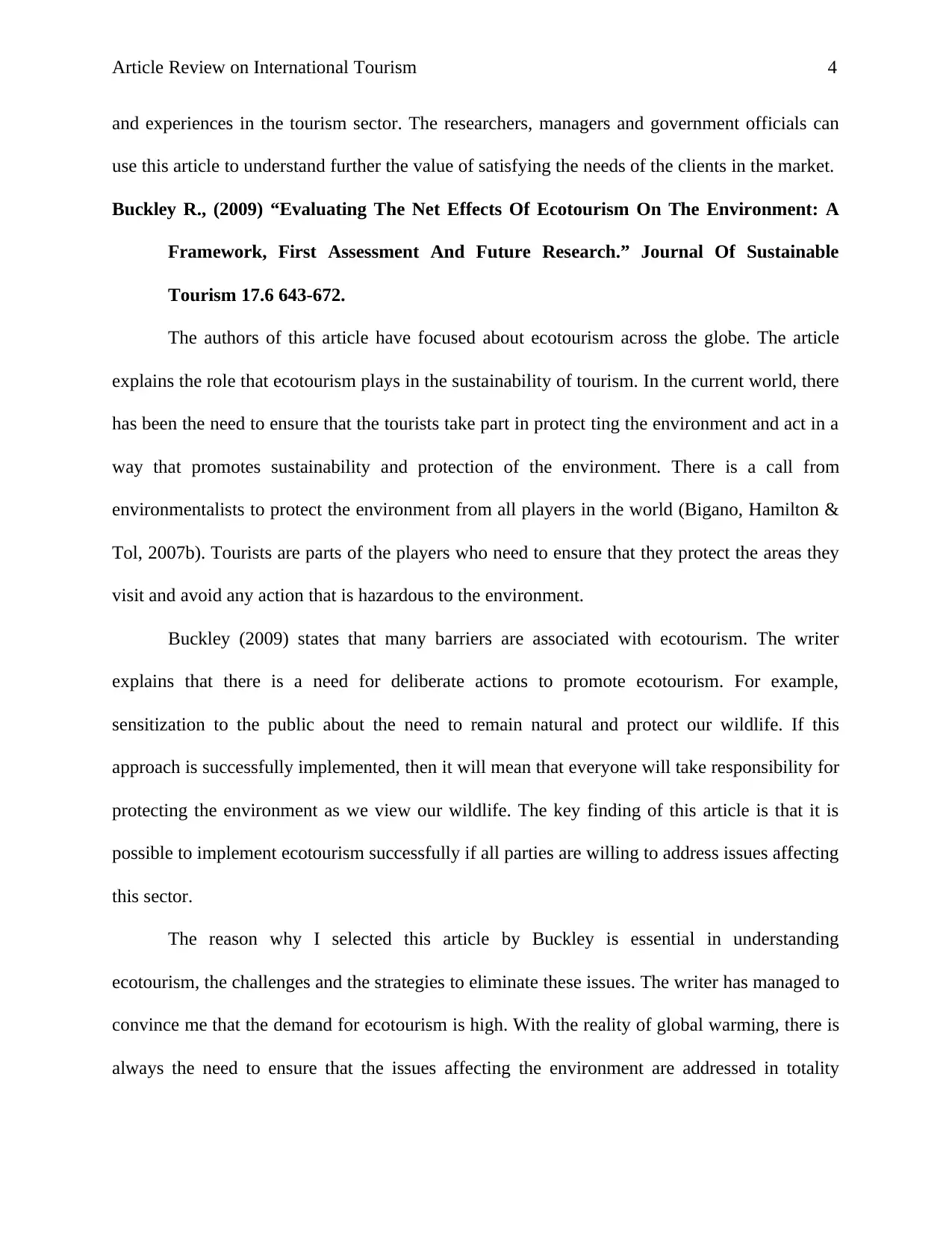
Article Review on International Tourism 4
and experiences in the tourism sector. The researchers, managers and government officials can
use this article to understand further the value of satisfying the needs of the clients in the market.
Buckley R., (2009) “Evaluating The Net Effects Of Ecotourism On The Environment: A
Framework, First Assessment And Future Research.” Journal Of Sustainable
Tourism 17.6 643-672.
The authors of this article have focused about ecotourism across the globe. The article
explains the role that ecotourism plays in the sustainability of tourism. In the current world, there
has been the need to ensure that the tourists take part in protect ting the environment and act in a
way that promotes sustainability and protection of the environment. There is a call from
environmentalists to protect the environment from all players in the world (Bigano, Hamilton &
Tol, 2007b). Tourists are parts of the players who need to ensure that they protect the areas they
visit and avoid any action that is hazardous to the environment.
Buckley (2009) states that many barriers are associated with ecotourism. The writer
explains that there is a need for deliberate actions to promote ecotourism. For example,
sensitization to the public about the need to remain natural and protect our wildlife. If this
approach is successfully implemented, then it will mean that everyone will take responsibility for
protecting the environment as we view our wildlife. The key finding of this article is that it is
possible to implement ecotourism successfully if all parties are willing to address issues affecting
this sector.
The reason why I selected this article by Buckley is essential in understanding
ecotourism, the challenges and the strategies to eliminate these issues. The writer has managed to
convince me that the demand for ecotourism is high. With the reality of global warming, there is
always the need to ensure that the issues affecting the environment are addressed in totality
and experiences in the tourism sector. The researchers, managers and government officials can
use this article to understand further the value of satisfying the needs of the clients in the market.
Buckley R., (2009) “Evaluating The Net Effects Of Ecotourism On The Environment: A
Framework, First Assessment And Future Research.” Journal Of Sustainable
Tourism 17.6 643-672.
The authors of this article have focused about ecotourism across the globe. The article
explains the role that ecotourism plays in the sustainability of tourism. In the current world, there
has been the need to ensure that the tourists take part in protect ting the environment and act in a
way that promotes sustainability and protection of the environment. There is a call from
environmentalists to protect the environment from all players in the world (Bigano, Hamilton &
Tol, 2007b). Tourists are parts of the players who need to ensure that they protect the areas they
visit and avoid any action that is hazardous to the environment.
Buckley (2009) states that many barriers are associated with ecotourism. The writer
explains that there is a need for deliberate actions to promote ecotourism. For example,
sensitization to the public about the need to remain natural and protect our wildlife. If this
approach is successfully implemented, then it will mean that everyone will take responsibility for
protecting the environment as we view our wildlife. The key finding of this article is that it is
possible to implement ecotourism successfully if all parties are willing to address issues affecting
this sector.
The reason why I selected this article by Buckley is essential in understanding
ecotourism, the challenges and the strategies to eliminate these issues. The writer has managed to
convince me that the demand for ecotourism is high. With the reality of global warming, there is
always the need to ensure that the issues affecting the environment are addressed in totality
Paraphrase This Document
Need a fresh take? Get an instant paraphrase of this document with our AI Paraphraser
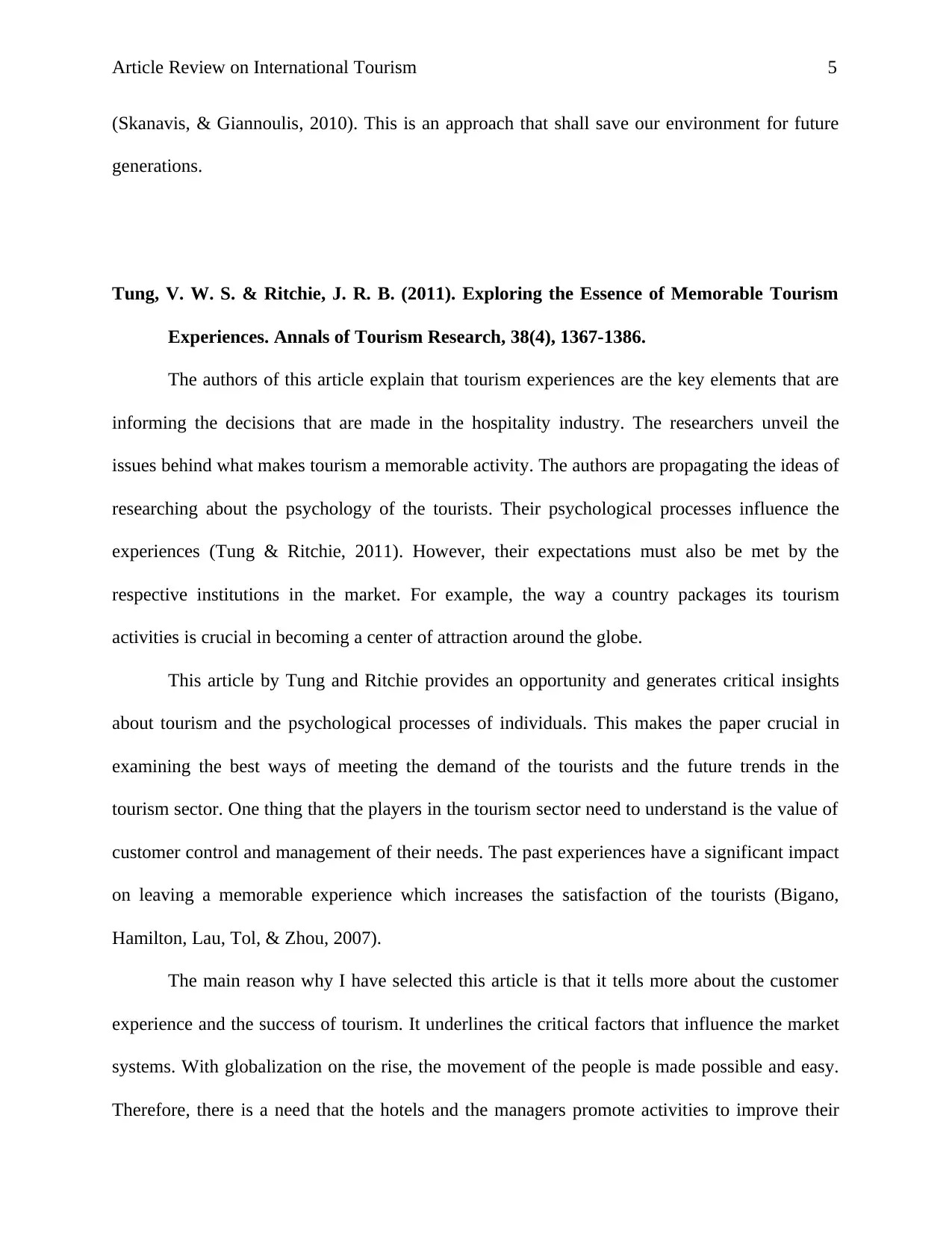
Article Review on International Tourism 5
(Skanavis, & Giannoulis, 2010). This is an approach that shall save our environment for future
generations.
Tung, V. W. S. & Ritchie, J. R. B. (2011). Exploring the Essence of Memorable Tourism
Experiences. Annals of Tourism Research, 38(4), 1367‐1386.
The authors of this article explain that tourism experiences are the key elements that are
informing the decisions that are made in the hospitality industry. The researchers unveil the
issues behind what makes tourism a memorable activity. The authors are propagating the ideas of
researching about the psychology of the tourists. Their psychological processes influence the
experiences (Tung & Ritchie, 2011). However, their expectations must also be met by the
respective institutions in the market. For example, the way a country packages its tourism
activities is crucial in becoming a center of attraction around the globe.
This article by Tung and Ritchie provides an opportunity and generates critical insights
about tourism and the psychological processes of individuals. This makes the paper crucial in
examining the best ways of meeting the demand of the tourists and the future trends in the
tourism sector. One thing that the players in the tourism sector need to understand is the value of
customer control and management of their needs. The past experiences have a significant impact
on leaving a memorable experience which increases the satisfaction of the tourists (Bigano,
Hamilton, Lau, Tol, & Zhou, 2007).
The main reason why I have selected this article is that it tells more about the customer
experience and the success of tourism. It underlines the critical factors that influence the market
systems. With globalization on the rise, the movement of the people is made possible and easy.
Therefore, there is a need that the hotels and the managers promote activities to improve their
(Skanavis, & Giannoulis, 2010). This is an approach that shall save our environment for future
generations.
Tung, V. W. S. & Ritchie, J. R. B. (2011). Exploring the Essence of Memorable Tourism
Experiences. Annals of Tourism Research, 38(4), 1367‐1386.
The authors of this article explain that tourism experiences are the key elements that are
informing the decisions that are made in the hospitality industry. The researchers unveil the
issues behind what makes tourism a memorable activity. The authors are propagating the ideas of
researching about the psychology of the tourists. Their psychological processes influence the
experiences (Tung & Ritchie, 2011). However, their expectations must also be met by the
respective institutions in the market. For example, the way a country packages its tourism
activities is crucial in becoming a center of attraction around the globe.
This article by Tung and Ritchie provides an opportunity and generates critical insights
about tourism and the psychological processes of individuals. This makes the paper crucial in
examining the best ways of meeting the demand of the tourists and the future trends in the
tourism sector. One thing that the players in the tourism sector need to understand is the value of
customer control and management of their needs. The past experiences have a significant impact
on leaving a memorable experience which increases the satisfaction of the tourists (Bigano,
Hamilton, Lau, Tol, & Zhou, 2007).
The main reason why I have selected this article is that it tells more about the customer
experience and the success of tourism. It underlines the critical factors that influence the market
systems. With globalization on the rise, the movement of the people is made possible and easy.
Therefore, there is a need that the hotels and the managers promote activities to improve their
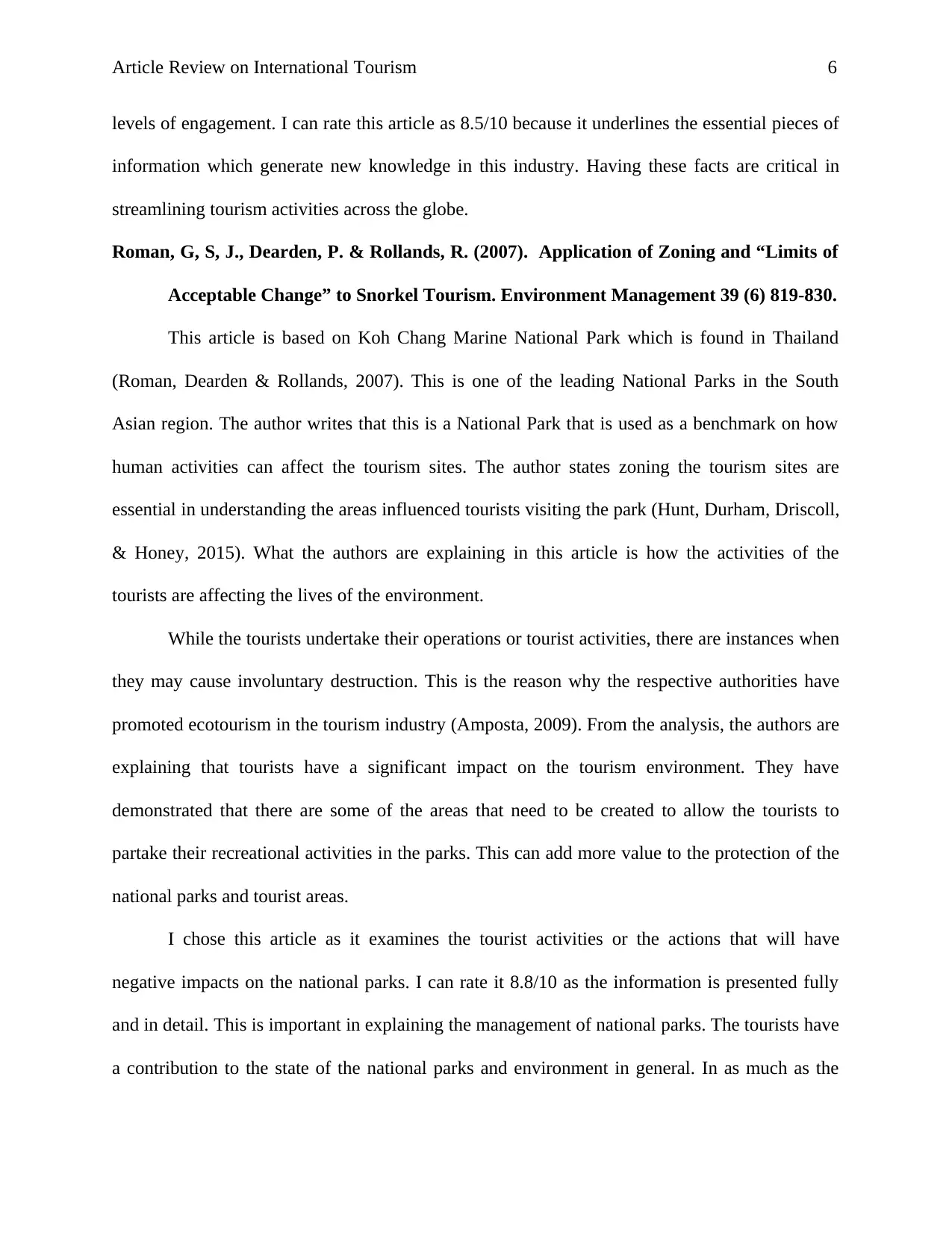
Article Review on International Tourism 6
levels of engagement. I can rate this article as 8.5/10 because it underlines the essential pieces of
information which generate new knowledge in this industry. Having these facts are critical in
streamlining tourism activities across the globe.
Roman, G, S, J., Dearden, P. & Rollands, R. (2007). Application of Zoning and “Limits of
Acceptable Change” to Snorkel Tourism. Environment Management 39 (6) 819-830.
This article is based on Koh Chang Marine National Park which is found in Thailand
(Roman, Dearden & Rollands, 2007). This is one of the leading National Parks in the South
Asian region. The author writes that this is a National Park that is used as a benchmark on how
human activities can affect the tourism sites. The author states zoning the tourism sites are
essential in understanding the areas influenced tourists visiting the park (Hunt, Durham, Driscoll,
& Honey, 2015). What the authors are explaining in this article is how the activities of the
tourists are affecting the lives of the environment.
While the tourists undertake their operations or tourist activities, there are instances when
they may cause involuntary destruction. This is the reason why the respective authorities have
promoted ecotourism in the tourism industry (Amposta, 2009). From the analysis, the authors are
explaining that tourists have a significant impact on the tourism environment. They have
demonstrated that there are some of the areas that need to be created to allow the tourists to
partake their recreational activities in the parks. This can add more value to the protection of the
national parks and tourist areas.
I chose this article as it examines the tourist activities or the actions that will have
negative impacts on the national parks. I can rate it 8.8/10 as the information is presented fully
and in detail. This is important in explaining the management of national parks. The tourists have
a contribution to the state of the national parks and environment in general. In as much as the
levels of engagement. I can rate this article as 8.5/10 because it underlines the essential pieces of
information which generate new knowledge in this industry. Having these facts are critical in
streamlining tourism activities across the globe.
Roman, G, S, J., Dearden, P. & Rollands, R. (2007). Application of Zoning and “Limits of
Acceptable Change” to Snorkel Tourism. Environment Management 39 (6) 819-830.
This article is based on Koh Chang Marine National Park which is found in Thailand
(Roman, Dearden & Rollands, 2007). This is one of the leading National Parks in the South
Asian region. The author writes that this is a National Park that is used as a benchmark on how
human activities can affect the tourism sites. The author states zoning the tourism sites are
essential in understanding the areas influenced tourists visiting the park (Hunt, Durham, Driscoll,
& Honey, 2015). What the authors are explaining in this article is how the activities of the
tourists are affecting the lives of the environment.
While the tourists undertake their operations or tourist activities, there are instances when
they may cause involuntary destruction. This is the reason why the respective authorities have
promoted ecotourism in the tourism industry (Amposta, 2009). From the analysis, the authors are
explaining that tourists have a significant impact on the tourism environment. They have
demonstrated that there are some of the areas that need to be created to allow the tourists to
partake their recreational activities in the parks. This can add more value to the protection of the
national parks and tourist areas.
I chose this article as it examines the tourist activities or the actions that will have
negative impacts on the national parks. I can rate it 8.8/10 as the information is presented fully
and in detail. This is important in explaining the management of national parks. The tourists have
a contribution to the state of the national parks and environment in general. In as much as the
⊘ This is a preview!⊘
Do you want full access?
Subscribe today to unlock all pages.

Trusted by 1+ million students worldwide
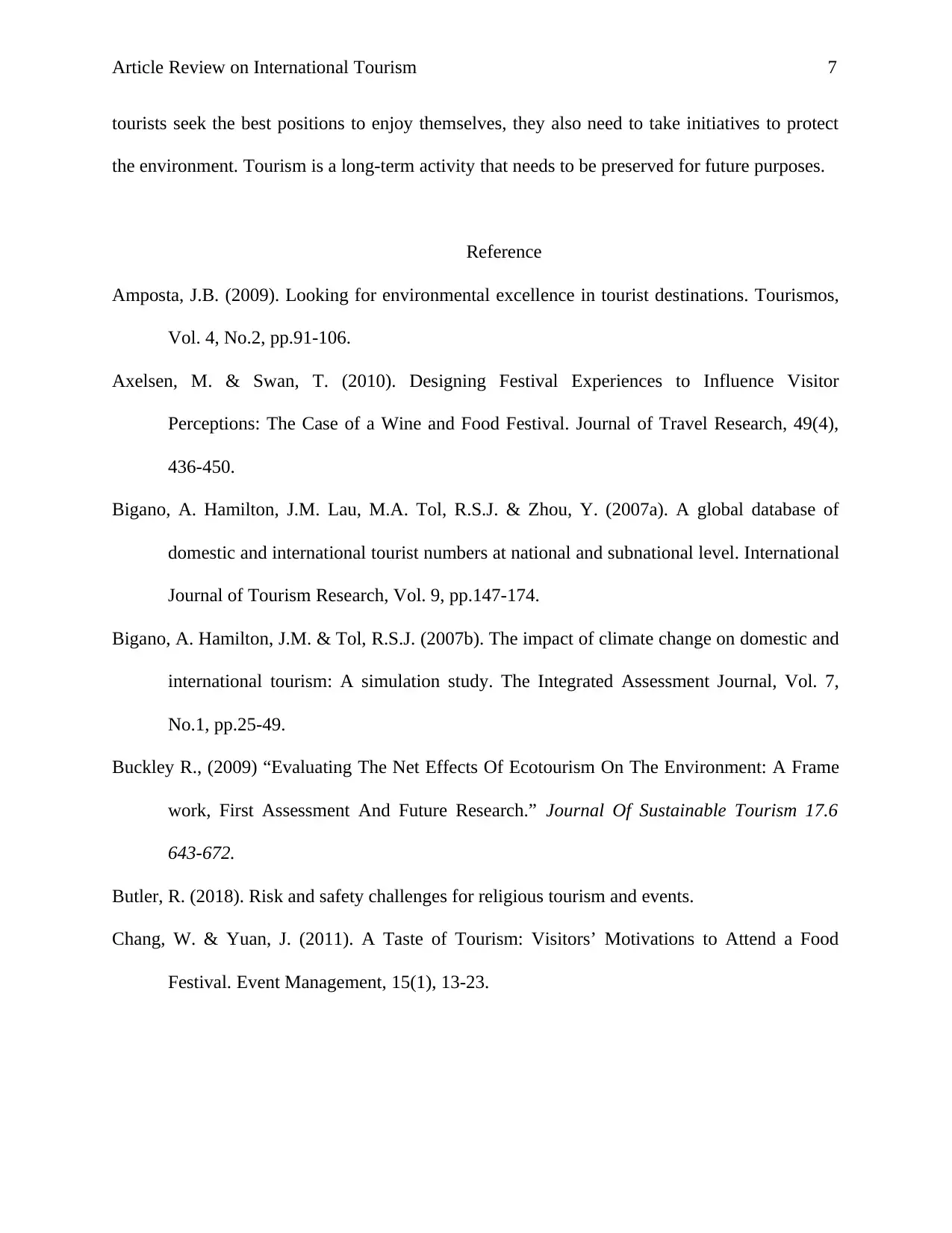
Article Review on International Tourism 7
tourists seek the best positions to enjoy themselves, they also need to take initiatives to protect
the environment. Tourism is a long-term activity that needs to be preserved for future purposes.
Reference
Amposta, J.B. (2009). Looking for environmental excellence in tourist destinations. Tourismos,
Vol. 4, No.2, pp.91-106.
Axelsen, M. & Swan, T. (2010). Designing Festival Experiences to Influence Visitor
Perceptions: The Case of a Wine and Food Festival. Journal of Travel Research, 49(4),
436‐450.
Bigano, A. Hamilton, J.M. Lau, M.A. Tol, R.S.J. & Zhou, Y. (2007a). A global database of
domestic and international tourist numbers at national and subnational level. International
Journal of Tourism Research, Vol. 9, pp.147-174.
Bigano, A. Hamilton, J.M. & Tol, R.S.J. (2007b). The impact of climate change on domestic and
international tourism: A simulation study. The Integrated Assessment Journal, Vol. 7,
No.1, pp.25-49.
Buckley R., (2009) “Evaluating The Net Effects Of Ecotourism On The Environment: A Frame
work, First Assessment And Future Research.” Journal Of Sustainable Tourism 17.6
643-672.
Butler, R. (2018). Risk and safety challenges for religious tourism and events.
Chang, W. & Yuan, J. (2011). A Taste of Tourism: Visitors’ Motivations to Attend a Food
Festival. Event Management, 15(1), 13‐23.
tourists seek the best positions to enjoy themselves, they also need to take initiatives to protect
the environment. Tourism is a long-term activity that needs to be preserved for future purposes.
Reference
Amposta, J.B. (2009). Looking for environmental excellence in tourist destinations. Tourismos,
Vol. 4, No.2, pp.91-106.
Axelsen, M. & Swan, T. (2010). Designing Festival Experiences to Influence Visitor
Perceptions: The Case of a Wine and Food Festival. Journal of Travel Research, 49(4),
436‐450.
Bigano, A. Hamilton, J.M. Lau, M.A. Tol, R.S.J. & Zhou, Y. (2007a). A global database of
domestic and international tourist numbers at national and subnational level. International
Journal of Tourism Research, Vol. 9, pp.147-174.
Bigano, A. Hamilton, J.M. & Tol, R.S.J. (2007b). The impact of climate change on domestic and
international tourism: A simulation study. The Integrated Assessment Journal, Vol. 7,
No.1, pp.25-49.
Buckley R., (2009) “Evaluating The Net Effects Of Ecotourism On The Environment: A Frame
work, First Assessment And Future Research.” Journal Of Sustainable Tourism 17.6
643-672.
Butler, R. (2018). Risk and safety challenges for religious tourism and events.
Chang, W. & Yuan, J. (2011). A Taste of Tourism: Visitors’ Motivations to Attend a Food
Festival. Event Management, 15(1), 13‐23.
Paraphrase This Document
Need a fresh take? Get an instant paraphrase of this document with our AI Paraphraser
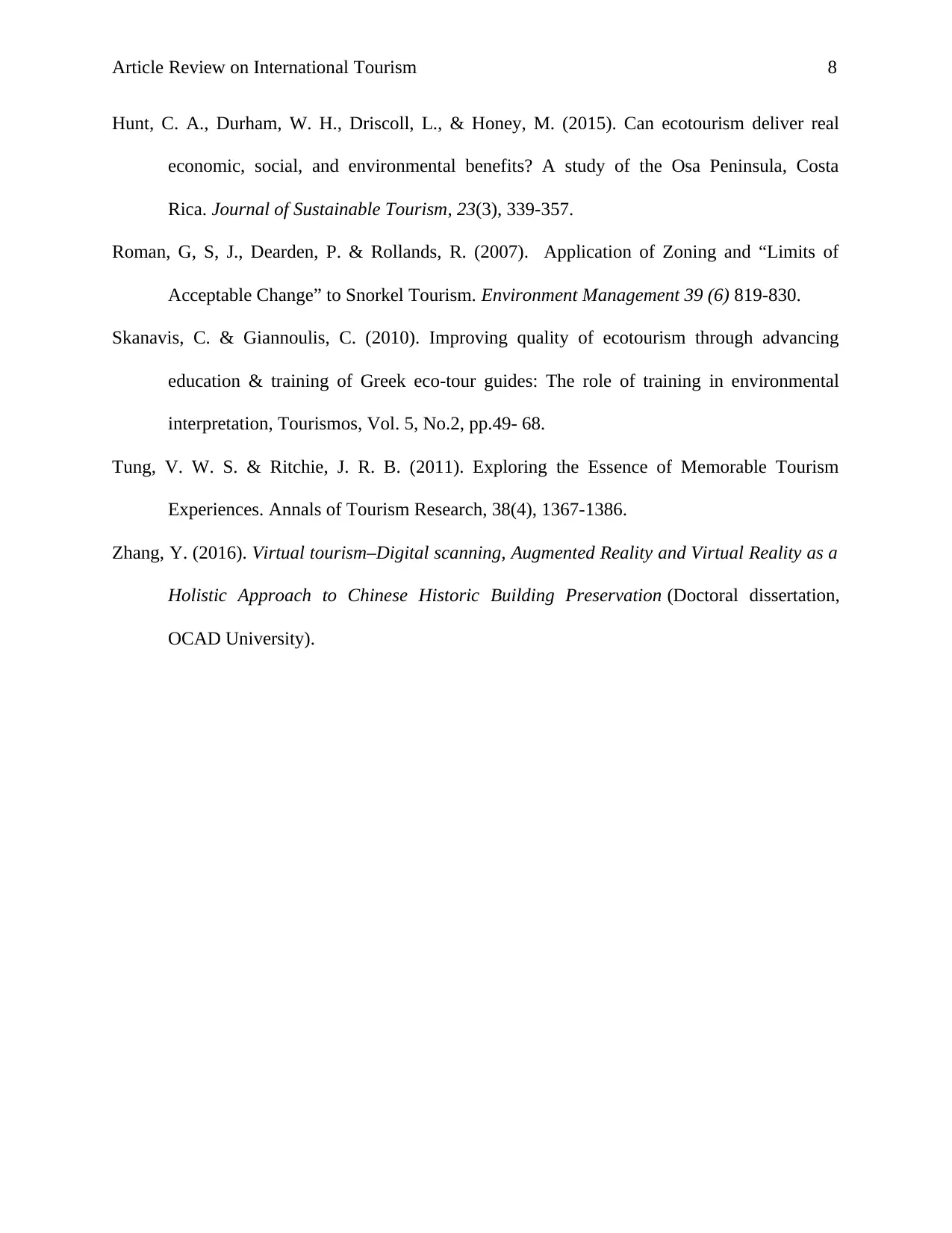
Article Review on International Tourism 8
Hunt, C. A., Durham, W. H., Driscoll, L., & Honey, M. (2015). Can ecotourism deliver real
economic, social, and environmental benefits? A study of the Osa Peninsula, Costa
Rica. Journal of Sustainable Tourism, 23(3), 339-357.
Roman, G, S, J., Dearden, P. & Rollands, R. (2007). Application of Zoning and “Limits of
Acceptable Change” to Snorkel Tourism. Environment Management 39 (6) 819-830.
Skanavis, C. & Giannoulis, C. (2010). Improving quality of ecotourism through advancing
education & training of Greek eco-tour guides: The role of training in environmental
interpretation, Tourismos, Vol. 5, No.2, pp.49- 68.
Tung, V. W. S. & Ritchie, J. R. B. (2011). Exploring the Essence of Memorable Tourism
Experiences. Annals of Tourism Research, 38(4), 1367‐1386.
Zhang, Y. (2016). Virtual tourism–Digital scanning, Augmented Reality and Virtual Reality as a
Holistic Approach to Chinese Historic Building Preservation (Doctoral dissertation,
OCAD University).
Hunt, C. A., Durham, W. H., Driscoll, L., & Honey, M. (2015). Can ecotourism deliver real
economic, social, and environmental benefits? A study of the Osa Peninsula, Costa
Rica. Journal of Sustainable Tourism, 23(3), 339-357.
Roman, G, S, J., Dearden, P. & Rollands, R. (2007). Application of Zoning and “Limits of
Acceptable Change” to Snorkel Tourism. Environment Management 39 (6) 819-830.
Skanavis, C. & Giannoulis, C. (2010). Improving quality of ecotourism through advancing
education & training of Greek eco-tour guides: The role of training in environmental
interpretation, Tourismos, Vol. 5, No.2, pp.49- 68.
Tung, V. W. S. & Ritchie, J. R. B. (2011). Exploring the Essence of Memorable Tourism
Experiences. Annals of Tourism Research, 38(4), 1367‐1386.
Zhang, Y. (2016). Virtual tourism–Digital scanning, Augmented Reality and Virtual Reality as a
Holistic Approach to Chinese Historic Building Preservation (Doctoral dissertation,
OCAD University).
1 out of 8
Related Documents
Your All-in-One AI-Powered Toolkit for Academic Success.
+13062052269
info@desklib.com
Available 24*7 on WhatsApp / Email
![[object Object]](/_next/static/media/star-bottom.7253800d.svg)
Unlock your academic potential
Copyright © 2020–2025 A2Z Services. All Rights Reserved. Developed and managed by ZUCOL.





